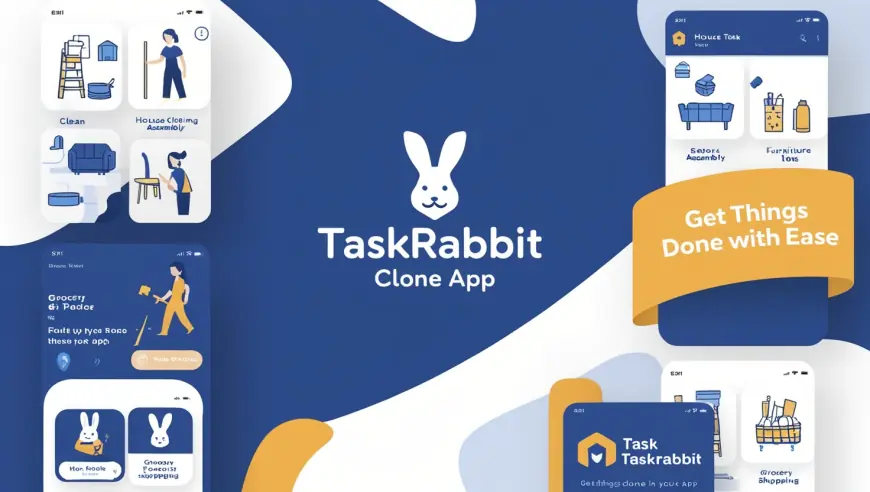How to Create Your Own Home Service Platform Using a TaskRabbit Clone App
Learn how to create your own home service platform using a TaskRabbit clone app. Build, customize, and grow your service-based business easily.

In today’s fast-paced world, convenience is key. Many individuals look for reliable, on-demand services to help with tasks around the house. Whether it's plumbing, cleaning, furniture assembly, or even pet-sitting, the demand for home service providers is ever-growing. If you’ve thought about capitalizing on this trend, starting your own home service platform can be a rewarding venture.
With the advent of technology, creating such a platform doesn’t have to be a complex task. One way to fast-track this process is by using a TaskRabbit clone app. This solution offers a foundation that mimics the successful TaskRabbit model, saving you time and resources while providing a functional system for your platform.
Here’s how you can create your own home service platform using a TaskRabbit clone app:
1. Understand the Market Demand
Before you launch your platform, research the specific needs of your target audience. Different regions may have varying demands for home services. Some areas may need more cleaners, while others may need electricians, movers, or personal assistants. Start by analyzing local trends and gathering feedback from potential customers. Conduct surveys or focus groups to pinpoint what services are most in demand.
Once you’ve gathered enough data, you can tailor your platform to cater to these needs. The beauty of using a TaskRabbit clone app is that you can customize it to support specific tasks that align with your market’s requirements.
2. Choose the Right TaskRabbit Clone App
Selecting the right app is crucial. You want a clone app that can handle the demands of your business and support scalability. There are various clone apps available that replicate TaskRabbit's core functionality. When choosing one, consider these factors:
- Ease of Use: The app should have a simple and intuitive user interface (UI) for both service providers and customers.
- Payment Integration: Ensure the app has a secure, reliable payment gateway that supports various payment methods, such as credit cards, mobile payments, or even cryptocurrency.
- GPS Integration: The app should offer GPS functionality to connect service providers with customers in their vicinity, allowing for real-time tracking.
- Ratings and Reviews: Customers should be able to rate service providers and leave feedback. This promotes transparency and trust.
- Notification System: The app should have real-time notifications for both customers and service providers to ensure smooth communication.
Investing in the right TaskRabbit clone app will set the stage for a smooth launch and operation of your platform.
3. Customize the App to Fit Your Brand
Once you have the clone app, it’s time to make it your own. Customization is key to making your platform stand out. This involves several aspects:
- Branding: Your app’s visual elements should reflect your brand. Customize the color scheme, logo, and layout to align with your business’s identity.
- Feature Modifications: Depending on your target market, you may want to add or remove certain features. For instance, if you’re focusing on a specific niche like pet care, include features that cater to that market.
- User Experience (UX): Make sure the app’s design enhances user experience. Simplify the process for users to book services and for providers to manage their tasks. The easier it is to navigate, the more likely people are to use it.
- Backend Configuration: Work with full cycle software developers to adjust the backend of the app, making sure it’s capable of supporting the number of users you expect. The app should be able to scale as your business grows.
Customizing the app allows you to create a platform that resonates with your audience and stands out in a competitive market.
4. Build a Network of Service Providers
Your platform’s success depends heavily on the quality and reliability of the service providers you bring on board. Building a solid network is essential. You can attract skilled professionals through:
- Online Advertising: Use social media platforms, job boards, and industry-specific websites to recruit service providers.
- Referral Programs: Encourage your current providers to refer others by offering incentives or bonuses.
- Partnerships: Collaborate with training institutes or certification programs to ensure the service providers meet specific standards.
Offer clear guidelines on the qualifications and skills you expect from service providers. This will ensure that the professionals on your platform are reliable and provide quality services.
5. Implement a Comprehensive Booking System
Your app should allow customers to easily book services. A well-designed booking system will allow users to:
- Choose the service they need
- Select the time and date for the job
- View available service providers in their area
- Set preferences (e.g., preferred service provider, type of service, etc.)
This should be done with minimal steps, ensuring that booking a service is quick and hassle-free. It should also support real-time updates and notifications, so customers and service providers are on the same page regarding appointments.
To add an extra layer of convenience, you can also include options for recurring bookings for customers who need services on a regular basis.
6. Set Clear Pricing and Payment Policies
Transparency is vital when it comes to pricing. You’ll need to set up a clear pricing structure for the services offered on your platform. A few considerations:
- Hourly Rate vs. Fixed Rate: Some services, like cleaning, may work well with an hourly rate, while others, like furniture assembly, may be better suited for a fixed rate.
- Surge Pricing: You can implement surge pricing for peak demand periods (e.g., holidays or weekends), allowing service providers to earn more during these times.
- Payment Methods: As mentioned earlier, ensure that you have a reliable payment gateway to handle all transactions. Your platform should support different payment methods and provide secure processing.
- Service Provider Payouts: Set clear guidelines on how and when service providers get paid. A common practice is to pay providers on a weekly or bi-weekly basis, but you can customize this depending on your platform’s needs.
Having a transparent payment policy reduces disputes and helps build trust between customers and service providers.
7. Implement a Rating and Review System
A rating and review system is critical for establishing credibility. Both customers and service providers should be able to rate each other after a task is completed. Reviews provide valuable feedback that can help users decide whether to book a service provider or not. Positive reviews will also motivate service providers to continue delivering high-quality services.
Here’s how you can implement a review system:
- Customer Reviews: After a service is completed, customers should be able to leave a rating and detailed review about the service provider’s performance.
- Service Provider Reviews: Service providers should also be able to rate customers. This helps maintain a balanced relationship and ensures both parties are respectful and responsible.
- Dispute Resolution: In case of negative reviews or issues, your platform should have a dispute resolution system to handle complaints. This will ensure any misunderstandings are addressed swiftly.
Reviews build trust and loyalty, encouraging users to return to your platform.
8. Focus on Customer Support
Customer support plays a pivotal role in the success of your home service platform. You need to provide prompt and efficient support for both customers and service providers. Here’s how:
- In-App Support: Offer an in-app support feature where users can easily contact customer service for help with issues or questions.
- Live Chat: Providing a live chat option ensures users can get instant help when needed.
- FAQs: Create a comprehensive FAQ section to answer common questions. This will reduce the number of repetitive inquiries and improve user satisfaction.
- Help Desk: Set up a help desk to resolve issues or complaints regarding bookings, payments, and service quality.
A responsive customer support system boosts confidence in your platform and ensures users feel taken care of at all times.
9. Implement Marketing Strategies
Once your platform is set up and running, it’s time to attract users. Use a variety of marketing strategies to increase visibility and drive traffic:
- Social Media Marketing: Use platforms like Instagram, Facebook, and LinkedIn to promote your services and connect with potential customers.
- Google Ads: Run targeted Google Ads campaigns to reach individuals searching for home services in your area.
- SEO: Optimize your website and app store listing to appear higher in search engine results.
- Referral Programs: Reward customers for referring others to your platform. This can help you build a loyal customer base quickly.
- Content Marketing: Create valuable content, such as blogs or tutorials, to attract organic traffic and build credibility.
Marketing helps you grow your platform and attract both customers and service providers.
10. Monitor Performance and Make Improvements
After launching your home service platform, it’s important to continuously monitor its performance. Use analytics tools to track key metrics such as user engagement, revenue, and customer feedback. Based on this data, make necessary improvements to optimize the user experience.
- User Behavior: Analyze how users interact with your platform to identify pain points. Are there steps in the booking process that customers find confusing? Are certain services more popular than others?
- Service Provider Performance: Track which service providers receive the best ratings and reviews, and promote them on the platform. Encourage providers to maintain high standards to keep customers happy.
- Technical Issues: Regularly check for bugs or technical glitches that could affect the user experience.
By monitoring performance and adjusting your platform accordingly, you can keep your service relevant and functional.
Conclusion
Creating a home service platform using a TaskRabbit clone app is a practical way to tap into the growing demand for on-demand services. By carefully choosing the right app, customizing it to fit your brand, building a solid network of service providers, and implementing effective marketing and support strategies, you can successfully launch and grow your platform. With a user-friendly interface, transparent pricing, and a focus on quality, your home service platform can provide value to both customers and service providers, establishing itself as a trusted solution in the market.
What's Your Reaction?
 Like
0
Like
0
 Dislike
0
Dislike
0
 Love
0
Love
0
 Funny
0
Funny
0
 Angry
0
Angry
0
 Sad
0
Sad
0
 Wow
0
Wow
0











































